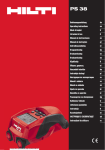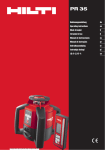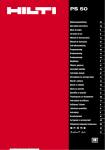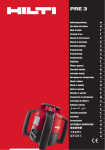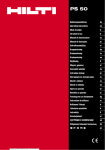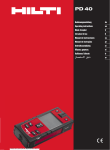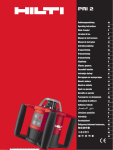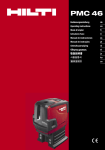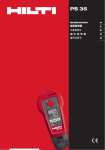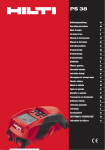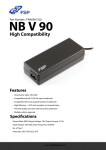Download Bedienungsanleitung de Operating instructions en Mode d
Transcript
PS 38 Printed: 08.07.2013 | Doc-Nr: PUB / 5070400 / 000 / 01 Bedienungsanleitung de Operating instructions en Mode d’emploi fr Istruzioni d’uso it Manual de instrucciones es Manual de instruções pt Gebruiksaanwijzing nl Brugsanvisning da Bruksanvisning sv Bruksanvisning no Käyttöohje fi Οδηγιες χρησεως el Használati utasítás hu Instrukcja obsługi pl Инструкция по зксплуатации ru Návod k obsluze cs Návod na obsluhu sk Upute za uporabu hr Navodila za uporabo sl Ръководство за обслужване bg Kulllanma Talimatı tr Lietošanas pamācība lv Instrukcija lt Kasutusjuhend et IНСТРУКЦIЯ З ЕКСПЛУАТАЦIЇ uk Instrucţiuni de utilizare ro 1 1 2 3 NU 5 11 10 9 13 14 Menu 4 4 12 4 8 15 Printed: 08.07.2013 | Doc-Nr: PUB / 5070400 / 000 / 01 16 4 6 4 7 2 1 12 PS 38 0cm 9 2 3.5cm 13 0cm 2 2 6 4 4 10 6 6 8 8 3 4 5 7 Universalmodus 11 8 3 2 1 NU 3 Printed: 08.07.2013 | Doc-Nr: PUB / 5070400 / 000 / 01 4 A A B B 5 c b a Printed: 08.07.2013 | Doc-Nr: PUB / 5070400 / 000 / 01 6 Printed: 08.07.2013 | Doc-Nr: PUB / 5070400 / 000 / 01 ORIGINAL OPERATING INSTRUCTIONS PS 38 Multidetector It is essential that the operating instructions are read before the tool is operated for the first time. Always keep these operating instructions together with the tool. Ensure that the operating instructions are with the tool when it is given to other persons. Contents 1 General information 2 Description 3 Technical data 4 Safety instructions 5 Before use 6 Operation 7 Care and maintenance 8 Troubleshooting 9 Disposal 10 Manufacturer’s warranty 11 EC declaration of conformity (original) Page 13 14 15 16 17 18 21 22 22 23 23 1 These numbers refer to the corresponding illustrations. The illustrations can be found on the fold-out cover pages. Keep these pages open while studying the operating instructions. In these operating instructions, the designation “the tool” always refers to the PS 38 Multidetector. Parts and operating controls 1 en @ Display ; Control panel = Battery compartment % Marking notches & Status LED (red / green) ( Sensor area ) Wheel + Wrist strap attachment point § On/off button / Measure button : Menu button · “Left” button $ “Down” button £ “Right” button | Service cover ¡ Type identification plate Display 2 @ Signal tone indicator ; Battery status indicator = Sensor area indicator % Already scanned area & Scale showing approximate depth of the object ( Unscanned area ) Position of outside edge (for marking a detected object at one of the lateral marking notches) + Scanning mode indicator § Gray: detected object is outside the sensor area / Black: detected object is inside the sensor area : The middle line corresponds with the upper marking notch · Approximate depth of the object $ Object category or live cable indicator 1 General information 1.1 Safety notices and their meaning DANGER Draws attention to imminent danger that will lead to serious bodily injury or fatality. WARNING Draws attention to a potentially dangerous situation that could lead to serious personal injury or fatality. CAUTION Draws attention to a potentially dangerous situation that could lead to slight personal injury or damage to the equipment or other property. NOTE Draws attention to an instruction or other useful information. 1.2 Explanation of the pictograms and other information Warning signs General warning 13 Printed: 08.07.2013 | Doc-Nr: PUB / 5070400 / 000 / 01 Symbols en Read the operating instructions before use. Location of identification data on the tool The type designation and serial number can be found on the type identification plate on the tool. Make a note of this data in your operating instructions and always refer to it when making an enquiry to your Hilti representative or service department. Return waste material for recycling. Type: Generation: 01 Serial no.: 2 Description 2.1 Use of the product as directed The PS 38 Multidetector is designed to detect objects such as ferrous metals (rebars), non-ferrous metals (copper and aluminium), wood beams, plastic pipes, electric cables in dry materials. Further information and examples of applications can be found at www.hilti.com/detection The tool and its ancillary equipment may present hazards when used incorrectly by untrained personnel or when used not as directed. Observe the information printed in the operating instructions concerning operation, care and maintenance. Take the influences of the surrounding area into account. Do not use the tool or appliance where there is a risk of fire or explosion. Modification of the tool is not permissible. 2.2 Displaying object categories Symbol Ferrous metal Symbol Non-ferrous metal Symbol Plastic / wood Symbol Live electric cable Symbol Unknown object 2.3 Detectable objects - Steel reinforcing bars - Metal pipes (e.g. steel, copper, aluminium) - Plastic pipes (e.g. plastic pipes containing water, e.g. floor or wall heating, etc.) - Cavities 14 Printed: 08.07.2013 | Doc-Nr: PUB / 5070400 / 000 / 01 - Wood beams - Electric cables (irrespective of whether the cables are live or not) - Three-phase electric cables (e.g. for electric cookers) - Low-voltage cables (e.g. for doorbells or telephones) 2.4 Materials suitable for scanning - Concrete / steel reinforced concrete - Masonry (brick, cellular concrete, expanded concrete, pumice concrete, sand-lime block) - Materials beneath surfaces such as plaster, tiles, wallpaper, parquet, carpet - Wood, plasterboard / gypsum board en 2.5 Scanning limitations Due to the scanning principle employed, certain unfavorable circumstances may negatively affect the result: - Multiple layers on walls or floors - Empty plastic pipes in hollow brick, wood beams in cavities and in drywall partitions - Objects that run through the wall at an angle - Metal surfaces and damp areas; under certain circumstances, these may be detected as objects in the material being scanned - Cavities in the material being scanned; these may be detected as objects - Proximity to appliances that emit powerful magnetic or electromagnetic fields, e.g. mobile or cordless phone base stations and generators 2.6 Items supplied 1 The tool 4 Batteries 1 1 1 1 1 1 Hand strap Operating instructions Manufacturer’s certificate Soft pouch Set of marking pens Hilti toolbox 3 Technical data Right of technical changes reserved. NOTE ¹⁾ Depends on scanning mode, the size and type of the object and on the condition and type of material to be scanned (see fig. 5 on the cover pages). PS 38 Maximum detection range for locating objects ¹⁾ 12 cm (4.7 in) Location accuracy (to the middle of the object) a ¹⁾ ± 5 mm (± 0.2 in) Depth measurement accuracy b ¹⁾ ± 10 mm (± 0.4 in) Minimum distance between two objects c ¹⁾ 4 cm (1.57 in) Operating temperature range -10…+50°C (14 °F ... 122 °F) Storage temperature range -20…+70°C (-4 °F ... 158 °F) Batteries 4 x 1.5 V LR06 (AA) Batteries 4 x 1.2 V HR06, KR06 (AA) Battery life (alkaline batteries) 5h Battery life (with 2500 mAh batteries) 7h 15 Printed: 08.07.2013 | Doc-Nr: PUB / 5070400 / 000 / 01 en Protection class IP 54 (protection against dust and water spray) Weight in accordance with EPTA procedure 01/2003 0.7 kg (1.5 lb) Dimensions (L x W x H) 195 mm x 90 mm x 75 mm (7.7 in x 3.5 in x 3.0 in) 4 Safety instructions In addition to the information relevant to safety given in each of the sections of these operating instructions, the following points must be strictly observed at all times. 4.1 Basic information concerning safety a) Keep children away from the tool. b) Check the display after switching the tool on. The display should show the Hilti logo and the name of the tool. The display then shows the current settings or the settings previously saved. c) Operation of the tool in the proximity of persons with a cardiac pacemaker is not permissible. d) Operation of the tool in the proximity of pregnant women is not permissible. e) Rapidly changing detection conditions may lead to inaccurate readings. f) Do not use the tool in the proximity of medical instruments and appliances. g) Do not drill at positions where the tool has located an object. h) The warnings shown in the display must always be observed. i) Due to the scanning principle employed, the results of the scan may be negatively affected by certain ambient conditions. These include, e.g. proximity to appliances that generate powerful magnetic or electromagnetic fields, dampness, construction materials containing metal, aluminium foil-backed insulation, multiple layers, materials with cavities or electrically conductive wall coverings or tiles. Accordingly, other sources of information (e.g. plans of the building) should also be consulted before beginning drilling, sawing or grinding in the area scanned. j) Take the influences of the surrounding area into account. Do not use the tool where there is a risk of fire or explosion. k) Make sure that the display area can be easily read (e.g. do not touch the display area with the fingers, keep the display area clean). l) Do not use the tool if it is defective. m) Always keep the detection area clean. n) Always check how the tool is set before using it. o) Operation of the tool in the proximity of military installations, airports or astronomical facilities is not permissible unless prior permission has been obtained. 16 Printed: 08.07.2013 | Doc-Nr: PUB / 5070400 / 000 / 01 4.2 Proper organization of the workplace Avoid unfavorable body positions when working from ladders. Make sure you work from a safe stance and stay in balance at all times. b) When the tool is brought into a warm environment from very cold conditions, or vice-versa, allow it to become acclimatized before use. c) Only use the tool within the defined limits. d) Observe the accident prevention regulations applicable in your country. a) 4.3 Electromagnetic compatibility The tool complies with the requirements of EN 302435. Accordingly, permission must be obtained prior to operating this tool, for example, in hospitals, atomic power stations or in the proximity of airports or mobile phone relay stations. 4.4 General safety instructions Check the condition of the tool before use. If the tool is found to be damaged, have it repaired at a Hilti Service Center. b) Keep the tool clean and dry at all times. c) Do not apply stickers or adhesive plates at the sensor area on the underside of the tool. Metal plates, in particular, will affect scanning results. d) Take care to ensure that the service cover on the tool is always securely closed. The service cover may be opened only at a Hilti Service Center. e) You must check the accuracy of the tool after it has been dropped or subjected to other mechanical stresses. f) Although the tool is designed for the tough conditions of jobsite use, as with other measuring instruments it should be treated with care. g) Although the tool is protected against the entry of moisture, it should be wiped dry before being put away in its transport container. h) Check the accuracy of the tool before using it for detection or measurement. a) 4.5 Electrical safety a) Keep the batteries out of reach of children. b) Remove the batteries from the tool if it is to remain unused for some time. The batteries will self-discharge and may begin to corrode if stored for a long period. c) Always replace all batteries at the same time. Use only batteries of the same capacity and from the same manufacturer. d) Do not allow the batteries to overheat and do not expose them to fire. The batteries may explode or release toxic substances. e) Do not charge the batteries. f) Do not solder the batteries into the tool. g) Do not discharge the batteries by short-circuiting. This may cause them to overheat and present a risk of personal injury (burns). h) Do not attempt to open the batteries and do not subject them to excessive mechanical stress. 4.6 Transport Always remove the batteries before shipping the tool. 5 Before use cavities in bricks). The currently active setting is shown in the lower area of the display. 5.3.1 Universal mode (default setting) 5.1 Inserting the batteries 3 CAUTION Do not use damaged batteries. CAUTION Always replace the complete set of batteries. CAUTION Do not mix old and new batteries. Do not mix batteries of different makes or types. 1. 2. 3. Release the catch on the underside of the tool and open the battery compartment cover. Insert the batteries in the tool. Close the cover and check that it engages in the closed position. NOTE Take care to observe correct polarity (see symbols in battery compartment). The battery status indicator in the display on the tool shows the charge status of the batteries. Check to ensure that the battery compartment cover is closed correctly. 5.2 Switching the tool on / off 1. 2. Switch the tool on by pressing the on/off button. The status LED lights green and the display shows the start-up screen. When the tool is already switched on, press the on/off button: The tool switches off. NOTE If the warning “Change batteries” is shown in the display the settings will be saved and the tool then switches itself off automatically. NOTE If no scan is made or no button is pressed, the tool will switch itself off automatically after 5 minutes. The switch-off time can be set in menu mode (see section 5.5.4 “Switch-off time”). 5.3 Changing the scanning mode The “Left” and “Right” buttons can be used to scroll through the various scanning modes. By changing the scanning mode the tool can be adjusted to achieve optimum results on various materials and, where necessary, detection of undesired objects can be suppressed (e.g. The scanning mode for most applications in solid masonry or concrete is “Universal mode”. In this mode, metal or plastic objects and electric cables are detected. Cavities in brick or empty plastic pipes with a diameter of less than 2 cm (0.8 in) will probably not be detected. The maximum detection depth is 8 cm (3.2 in). 5.3.2 Concrete The “Concrete” scanning mode is particularly suitable for use on concrete. In this mode, steel reinforcing bars, plastic or metal pipes and electric cables are detected. The maximum detection depth is 12 cm (4.7 in). “Universal mode” should be selected in order to avoid scanning errors when the tool is used on thin concrete walls. 5.3.3 Floor heating The “Floor heating” scanning mode is particularly suitable for detecting metal, metal composite and water-filled plastic pipes or electric cables under a layer of screed. The maximum detection depth is 8 cm (3.2 in). NOTE Empty plastic pipes will not be found. 5.3.4 Drywall The “Drywall” scanning mode can be used to find wood beams, metal framing parts, pipes containing water and electric cables in drywall partitions. The maximum detection depth is 8 cm (3.2 in). NOTE Empty plastic pipes will not be found. 5.3.5 Hollow brick “Hollow brick” mode is suitable for use on masonry containing a large number of cavities. In this mode, metal objects, water-filled plastic pipes and live electric cables will be detected. The maximum detection depth is 8 cm (3.2 in). NOTE Empty plastic pipes and electric cables carrying no electric power will not be detected. 17 Printed: 08.07.2013 | Doc-Nr: PUB / 5070400 / 000 / 01 en 5.4 Changing the display mode 5.5.1 Navigating in the menu 1. DN 2. DN To access the menu items, press the “Down” button. The selected menu item is highlighted in gray. Press the “Left” or “Right” button to change the selected menu item. 5.5.2 Brightness en DN DN DN $PODSFUF The display mode can be changed in all scanning modes. This function changes only the display mode, not the scanning mode. To change from the standard display to distance measurement mode, press the “Left” or “Right” button for more than 2 seconds. The display mode can be changed again by pressing one of these buttons. NOTE Distance measurement mode can be used to measure the distance between objects. In the illustration shown, three equally spaced metal objects have been detected (see section 6.3.1 “Example showing rebars”). The distance scanned (from the starting point of the scan) is shown in the display below the approximate depth of the object, e.g. 20.1 cm (7.9 in), as shown in the example. The three objects detected, which are each a distance of 10 cm (3.9 in) apart, are shown as small rectangles above the scanning mode. 5.5 “Settings” menu To enter the “Settings” menu, press the “Menu” button. To leave the “Settings” menu, press the “Menu” button again. The settings selected up to this point will be saved and the tool then returns to the standard display screen. The brightness of the display can be adjusted in the “Brightness” menu. The default setting is “Max” (maximum brightness). 5.5.3 Signal tones In the “Signal tones” menu you can choose whether or not an audible signal is emitted when an object is detected. In the default setting, the signal tone is active. 5.5.4 Cut-off time The time interval before the tool switches itself off automatically when no scan is made or when no button is pressed can be set in the “Cut-off time” menu. The default setting is “5 min.”. 5.5.5 Default mode The mode to be used as standard after the tool is switched on can be set in the “Default mode” menu. “Universal mode” is the default setting. 5.5.6 Language The language used in the display and in the menus can be changed in the “Language” menu. “English” is the default setting. 5.5.7 Units Use this menu to select metric or imperial units of measure. The default setting is “metric”. 5.6 “Extended settings” menu To access the “Extended settings” menu, press the “Menu” button and the “On/off” button simultaneously while the tool is switched off. To leave the menu, press the “Measure” button. NOTE The submenus can be used to display information about the tool or to restore the default settings. 6 Operation 6.1 Using the tool 4 The tool scans in direction “A” to the depth indicated in the display. Scanning takes place only while the tool is being moved in direction “B” and so long as the tool is moved a distance of at least 10 cm (3.9 in). Always move the tool in a straight line over the area to 18 Printed: 08.07.2013 | Doc-Nr: PUB / 5070400 / 000 / 01 be scanned, applying light and even pressure so that the wheels remain securely in contact with the surface. Objects that differ from the material being scanned will be detected. The display shows the position of the object, its approximate depth and, when possible, the object category. Optimum results will be achieved when the scan has a length of at least 40 cm (15.7 in) and the tool is moved slowly over the surface to be scanned. Due to the operating principle employed, the upper edges of objects that lie transversely to the scanning direction will be reliably detected. Accordingly, always scan the area crosswise (i.e. in two scans perpendicular to each other) in order to avoid errors due to scanning along the length of an object. NOTE When several objects are positioned one above the other in the material being scanned, the object closest to the surface will be shown in the display. The image of the object shown in the display may differ from the actual characteristics of the object concerned. In particular, very thin objects will be shown thicker than they actually are. Large, cylindrical objects (e.g. plastic objects or water pipes) shown in the display may appear narrower than they actually are. 6.2.1 Locating objects $ en 3.5 cm 6.2 Scanning 1. 2. 3. Switch the tool on. The display shows the standard screen. Select the scanning mode that suits the material to be scanned. Place the tool on the surface to be scanned and move it in the required direction (see section 6.1 “Using the tool”). The result of the scan will be shown in the display after the tool has been moved a distance of at least 10 cm (3.9 in). In order to obtain correct results, move the tool slowly over the area to be scanned. NOTE If the tool is lifted away from the surface while making the scan, the most recent reading is shown in the display. The word “Hold” appears in the sensor area of the display. The scan restarts when the tool is brought back into contact with surface and moved again or the “Measure” button is pressed. NOTE The approximate depth and the object material category shown in the display refer to the object shown in black in the sensor area of the screen. The status LED lights red when an object is within the sensor area and lights green when no object is detected. When the status LED blinks red, a live cable is very probably within the sensor area. If an object is present below the sensor it is shown in the sensor area of the display. Depending on the size and depth of the object detected, the object category may also be shown. The approximate depth to the upper edge of the object detected is shown in the status line or can be read from the scale at the side of the display. % 3.5 1. 2. 3. 4. cm A single scan of the area is sufficient for initial location of an object. If no object is found, repeat the scan at right angles to the direction of the original scan (see section. 6.1 “Using the tool”). If you wish to locate an object exactly and mark its position, simply move the tool in the reverse direction back across the area already scanned. If an object appears in the display immediately below the center line, as shown in illustration A, the position of the object can be marked on the surface at the upper marking notch. NOTE However, this mark will be accurate only when the object runs exactly perpendicular to the direction of scan as the sensor area lies slightly below the marking notch. 19 Printed: 08.07.2013 | Doc-Nr: PUB / 5070400 / 000 / 01 5. To mark the position more exactly, move the tool to the left or right until the object detected is shown at the edge of the display. Mark the position of the detected object by making a mark beside the right or left marking notch (see illustration B). NOTE The object detected lies at the point of intersection of the upper and side marking notches. 6. en 6.3 Examples of scan results NOTE In the following examples, the signal tone is switched on. 6.3.1 Steel reinforcing bars A steel object, e.g. a steel rebar, is present in the sensor area. To the left and right of this are other objects which are outside the sensor area. The depth of the object is approx. 8 cm (3.1 in). The tool emits a signal tone. DN 14 DN DN 6.3.2 Copper pipes A non-ferrous metal object, e.g. a copper pipe, is within the sensor area. It lies at a depth of approx. 4 cm (1.6 in). The tool emits a signal tone. DN 14 DN 6OJWFSTBM Printed: 08.07.2013 | Doc-Nr: PUB / 5070400 / 000 / 01 DN 14 DN %SZXBMM 6.3.4 Live electric cables NOTE Depending on the size and depth of the object, it is not always possible to determine without doubt whether it is live (i.e. carrying electricity). NOTE When scanning, do not lay your hands on the surface of the material. DN DN NOTE Best scanning results will be obtained when the tool is moved at right angles to the longitudinal rebars, as described above. Mark the positions of the rebars found and then shift the tool to the adjoining are above or below and repeat the scan in order to verify the position of the rebars and the direction in which they run. To locate the transverse rebars, pivot the tool through 90° and scan between the already detected longitudinal rebars in order to avoid scanning along a longitudinal rebar. 20 DN $PODSFUF DN 6.3.3 Plastic or wooden objects A non-metallic object is within the sensor area. The object is made of plastic or wood (or is a cavity) and lies close to the surface. The tool emits a signal tone. 14 DN 6OJWFSTBM A live metallic object, e.g. an electric cable, is within the sensor area. It lies at a depth of approx. 1.5 cm (0.6 in). The tool emits a warning signal tone for “live cables” as soon as the electric cable is detected by the sensor. 6.3.5 Objects with a large surface area A metal object with a large surface area, e.g. a metal plate, is within the sensor area. It lies at a depth of approx. 2 cm (0.8 in). The tool emits a signal tone. DN 14 DN DN 14 DN DN 6OJWFSTBM 6.3.6 Unclear signals If a large number of objects are indicated in the standard display area, there can be two reasons for this. 1. The wall probably contains a large number of cavities (hollow brick). DN en 6OJWFSTBM Switch to “Hollow brick” mode. Most of the cavities will then no longer be shown in the display. If too many objects are still shown, several scans must be made at different heights and the position of the objects detected marked on the wall. Offset marks tend to indicate cavities while marks in a line tend to indicate an object. 2. The scan has been made longitudinally, i.e. along the length of an object. In this case, move the tool up or down and repeat the scan (see fig. 6 on the cover pages). 7 Care and maintenance 7.1 Cleaning and drying 1. 2. Use only a clean, soft cloth for cleaning. If necessary, moisten the cloth slightly with pure alcohol or a little water. NOTE Do not use any other liquids as these may damage the plastic components. The temperature limits for storage of your equipment must be observed, especially in winter / summer. 7.2 Storage Put the tool into storage only when dry. Please observe the applicable temperature limits when storing the tool. Check the accuracy of the equipment before it is used after a long period of storage. Remove the batteries from the tool before storing it for a long period. Leaking batteries may damage the tool. 7.3 Transport Use the Hilti toolbox or equivalent packaging when transporting the tool. CAUTION Always remove the batteries before shipping the tool. 7.4 Hilti Calibration Service We recommend that the tool is checked by the Hilti Calibration Service at regular intervals in order to verify its reliability in accordance with standards and legal requirements. Use can be made of the Hilti Calibration Service at any time, but checking at least once a year is recommended. The Calibration Service provides confirmation that the tool is in conformance, on the day it is tested, with the specifications given in the operating instructions. After checking, a calibration sticker applied to the tool and a calibration certificate provide written verification that the tool is operating in accordance with the manufacturer’s specification. Calibration certificates are always required by companies certified according to ISO 900x. Your local Hilti Center or representative will be pleased to provide further information. 21 Printed: 08.07.2013 | Doc-Nr: PUB / 5070400 / 000 / 01 8 Troubleshooting en Fault Possible cause Remedy The tool can’t be switched on. The batteries are exhausted. Replace the batteries. Incorrect battery polarity. Insert the batteries correctly and close the battery compartment cover. Remove and reinsert the batteries. The tool is switched on but doesn’t react. The tool is too cold or too hot. System error. The tool is too cold or too hot. “Slipping wheel” is shown in the display. A wheel lost contact with the wall. “Too fast” is shown in the display. “Out of temperature range” is shown in the display. The tool was moved too quickly. Temperature above permissible range. Wait until it is within the permissible temperature range. Press the “Measure” button. Take care to ensure that the wheels remain in contact with the surface when moving the tool. On uneven surfaces, place a sheet of thin cardboard between the wheels and the wall. Press the “Measure” button. Move the tool slowly over the wall. Wait until within the permissible temperature range. “Out of temperature range” is shown in the display. Temperature below permissible range. Wait until within the permissible temperature range. The display shows “Tool temperature” The temperature inside the tool has changed too quickly. Switch the tool on again. “Strong radio signal detected” is shown in the display. Interference caused by radio signal. The tool switches itself off automatically. If possible, eliminate the radio signal (e.g. WLAN, UMTS, aircraft radar, transmitter mast or microwave device) and switch the tool back on. 9 Disposal Most of the materials from which Hilti tools or appliances are manufactured can be recycled. The materials must be correctly separated before they can be recycled. In many countries, Hilti has already made arrangements for taking back old tools or appliances for recycling. Ask Hilti Customer Service or your Hilti representative for further information. For EC countries only Do not dispose of electrical appliances together with household waste. In observance of the European Directive on waste electrical and electronic equipment and its implementation in accordance with national law, electrical appliances that have reached the end of their life must be collected separately and returned to an environmentally compatible recycling facility. 22 Printed: 08.07.2013 | Doc-Nr: PUB / 5070400 / 000 / 01 10 Manufacturer’s warranty Hilti warrants that the tool supplied is free of defects in material and workmanship. This warranty is valid so long as the tool is operated and handled correctly, cleaned and serviced properly and in accordance with the Hilti Operating Instructions, and the technical system is maintained. This means that only original Hilti consumables, components and spare parts may be used in the tool. This warranty provides the free-of-charge repair or replacement of defective parts only over the entire lifespan of the tool. Parts requiring repair or replacement as a result of normal wear and tear are not covered by this warranty. Additional claims are excluded, unless stringent national rules prohibit such exclusion. In particular, Hilti is not obligated for direct, indirect, incidental or consequential damages, losses or expenses in connection with, or by reason of, the use of, or inability to use the tool for any purpose. Implied warranties of merchantability or fitness for a particular purpose are specifically excluded. For repair or replacement, send the tool or related parts immediately upon discovery of the defect to the address of the local Hilti marketing organization provided. This constitutes Hilti’s entire obligation with regard to warranty and supersedes all prior or contemporaneous comments and oral or written agreements concerning warranties. 11 EC declaration of conformity (original) Designation: Type: Generation: Year of design: Multidetector PS 38 Hilti Corporation, Feldkircherstrasse 100, FL‑9494 Schaan 01 2009 We declare, on our sole responsibility, that this product complies with the following directives and standards: 2011/65/EU, 2006/95/EC, 2004/108/EC, 1999/5/EC, EN ISO 12100, EN 302435-1, EN 302435-2. Paolo Luccini Head of BA Quality and Process Management Business Area Electric Tools & Accessories 01/2012 Matthias Gillner Executive Vice President Business Area Electric Tools & Accessories 01/2012 Technical documentation filed at: Hilti Entwicklungsgesellschaft mbH Zulassung Elektrowerkzeuge Hiltistrasse 6 86916 Kaufering Deutschland 23 Printed: 08.07.2013 | Doc-Nr: PUB / 5070400 / 000 / 01 en 12. FCC statement (US only) en -CAUTIONThis equipment has been tested and found to comply with the limits for a class B digital device, pursuant to part 15 of the FCC rules. These limits are designed to provide reasonable protection against harmful interference in a residential installation. This equipment generates, uses, and can radiate radiofrequency energy and, if not installed and used in accordance with the instructions, may cause harmful interference to radio communications. However, there is no guarantee that interference will not occur in a particular installation. If this equipment does cause harmful interference to radio or television reception, which can be determined by turning the equipment on and off, the user is encouraged to try to correct the interference by one or more of the following measures: • Re-orient or re-locate the receiving antenna. • Increase the distance between the equipment and receiver. • Connect the equipment to an outlet on a circuit different from that to which the receiver is connected. • Consult the dealer or an experienced TV/radio technician for assistance. -NOTEChanges or modifications not expressly approved by the party responsible for compliance could void the user’s authority to operate the equipment. This device complies with part 15 of the FCC Rules. Operation is subject to the following two conditions: 1) this device may not cause harmful interference, and 2) this device must accept any interference received, including interference that may cause undesired operation. For US customers: Operation of this device is restricted to law enforcement, fire and rescue officials, scientific research institutes, commercial mining companies, construction companies and private parties operating on behalf of these groups. Operation by any other party is a violation of 47 U.S.C. § 301 and could subject the operator to serious legal penalties. Coordination Requirements (a) UWB imaging systems require coordination through the FCC before the equipment may be used. The operator shall comply with any constraints on equipment usage resulting from this coordination. (b) The users of UWB imaging devices shall supply detailed operational areas to the FCC Office of Engi- Printed: 08.07.2013 | Doc-Nr: PUB / 5070400 / 000 / 01 neering and Technology who shall coordinate this information with the Federal Government through the National Telecommunications and Information Administration. The information provided by the UWB operator shall include the name, address and other pertinent contact information of the user, the desired geographical area of operation, and the FCC ID number and other nomenclature of the UWB device. This material shall be submitted to the following address: Frequency Coordination Branch, OET Federal Communications Commission 445 12th Street, SW Washington, D.C. 20554 ATTN: UWB Coordination (d) Users of authorized, coordinated UWB systems may transfer them to other qualified users and to different locations upon coordination of change of ownership or location to the FCC and coordination with existing authorized operations. (e) The NTIA/FCC coordination report shall include any needed constraints that apply to day-to-day operations. Such constraints could specify prohibited areas of operations or areas located near authorized radio stations for which additional coordination is required before operation of the UWB equipment. If additional local coordination is required, a local coordination contact will be provided. Ground Penetrating Radar Coordination Notice And Equipment Registration. Note: This form is only for Domestic United States users. Failure to do this is a violation of Federal law. 1. Date: 2. Company name: 3. Address: 4. Contact Information [contact name and phone number]: 5. Area Of Operation [state(s)]: 6. Equipment Identification Brand Name: PS 38 FCC-ID: SDL-PS38R01 7. Receipt Date Of Equipment: Fax this form to the FCC at: 202-418-1944 or mail to: Frequency Coordination Branch, OET Federal Communications Commission 445 12th Street, SW Washington, D.C. 20554 ATTN: UWB Coordination Do not send this information to Hilti Corporation. 13. IC statement (for Canada only) This device complies with the requirements defined in RSS-220 in conjunction with RSS-Gen of IC. Operation is subject to the following two conditions: 1) this device may not cause harmful interference, and 2) this device must accept any interference received, including interference that may cause undesired operation. Printed: 08.07.2013 | Doc-Nr: PUB / 5070400 / 000 / 01 For Canadian customers: This device shall be operated only where directed to the ground or wall, and is in contact with the ground or wall surface. This device shall be operated only by law enforcement agencies, scientific research institutes, commercial mining companies, construction companies, and emergency rescue or fire-fighting organizations. en Hilti Corporation Printed: 08.07.2013 | Doc-Nr: PUB / 5070400 / 000 / 01 419205 / A2 419205 Hilti = registered trademark of Hilti Corp., Schaan W 3767 | 0313 | 10-Pos. 1 | 1 Printed in Germany © 2013 Right of technical and programme changes reserved S. E. & O. *419205* LI-9494 Schaan Tel.: +423 / 234 21 11 Fax:+423 / 234 29 65 www.hilti.com



















